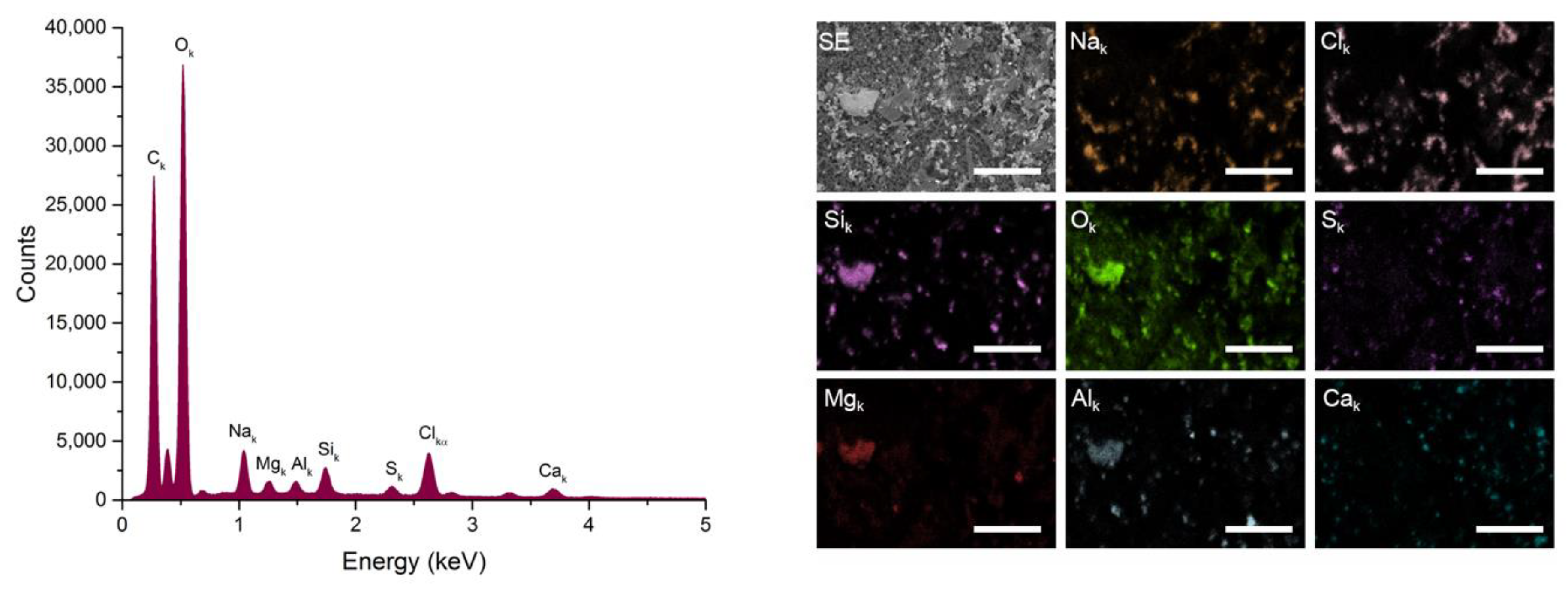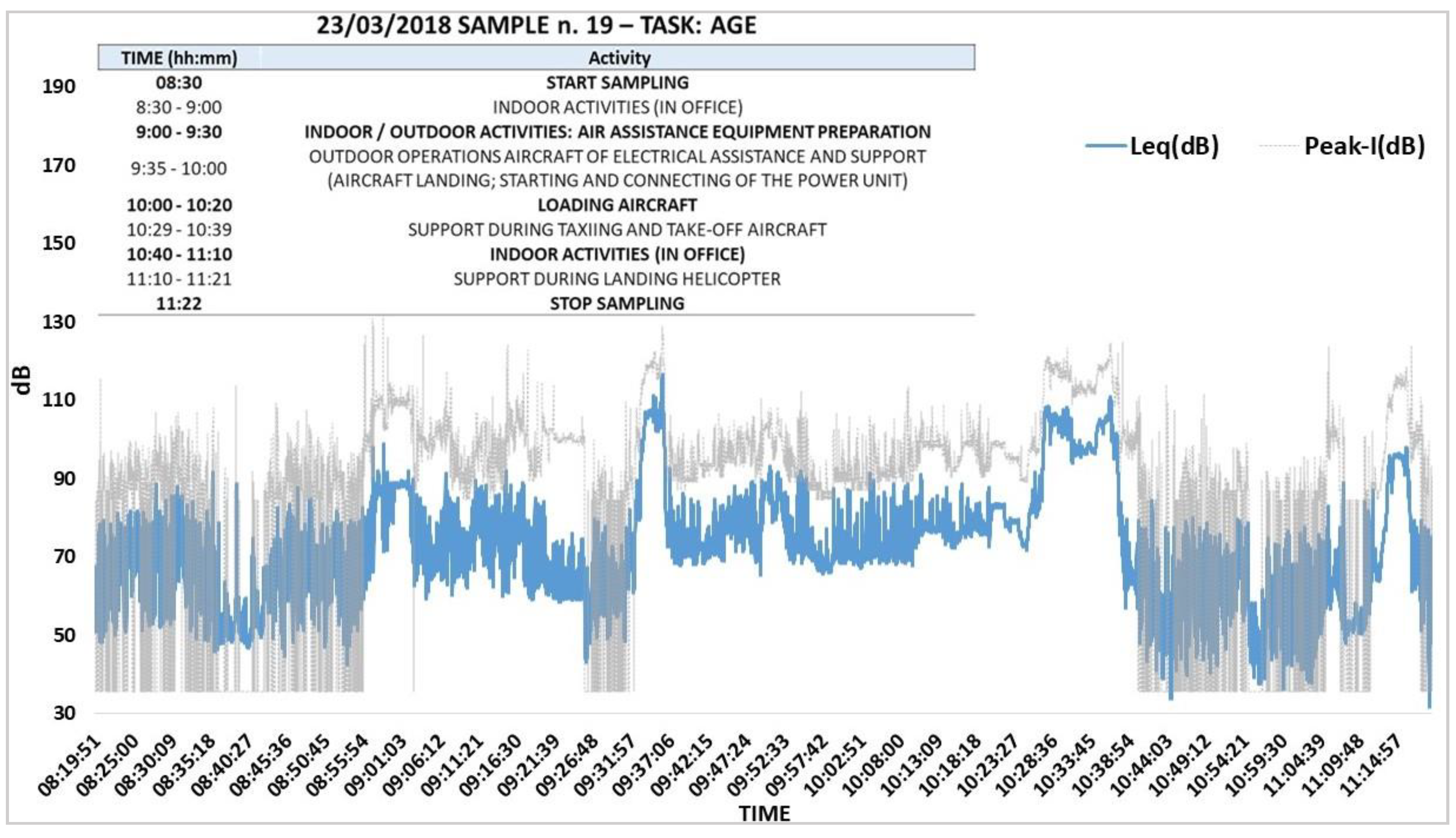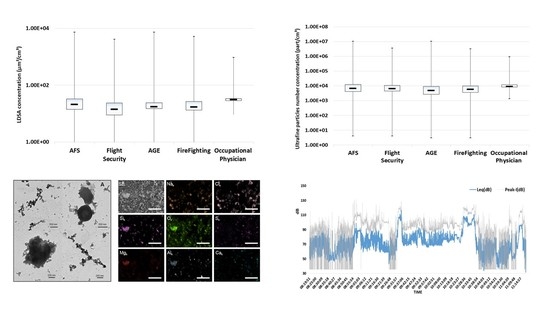Occupational Fine/Ultrafine Particles and Noise Exposure in Aircraft Personnel Operating in Airport Taxiway
Abstract
:1. Introduction
2. Materials and Methods
2.1. Study Design and Sampling Environment
2.2. Personal UFPs Monitoring
- UFPs Concentration (particles/cm3) individual and by homogeneous groups;
- UFPs Size (nm) individual and by homogeneous groups;
- Lung Deposition Surface Area (LDSA, µm2/cm3) UFPs concentration individual and by homogeneous groups;
- Total dose in term of LDSA (mm2) individual and by homogeneous groups.
- Dose LDSA mm2: The dose in terms of deposited lung surface area particles received by workers;
- LDSA µm2/cm3: Mean of lung deposition particles surface area concentration;
- Vol.cm3: Mean of total sampled volume on all subjects, corresponding to 143.63 L = 2 h 39 min.
2.3. Environmental UFPs Sampling
2.4. Noise Exposure Monitoring
2.5. Particle Morphological and Chemical Analysis
2.6. Statistical Analysis
3. Results
3.1. UFPs Personal Exposure
3.2. Particles Morphological and Chemical Analisys
3.3. Noise Exposure Assessment
4. Discussion
5. Conclusions
Author Contributions
Funding
Conflicts of Interest
References
- Campagna, M.; Frattolillo, A.; Pili, S.; Marcias, G.; Angius, N.; Mastino, C.C.; Cocco, P.; Buonanno, G. Environmental exposure to ultrafine particles inside and nearby a military airport. Atmosphere 2016, 7, 138. [Google Scholar] [CrossRef]
- Buonanno, G.; Bernabei, M.; Avino, P.; Stabile, L. Occupational exposure to airborne particles and other pollutants in an aviation base. Environ. Pollut. 2012, 170, 78–87. [Google Scholar] [CrossRef] [PubMed]
- Hu, S.; Fruin, S.; Kozawa, K.; Mara, S.; Winer, A.M.; Paulson, S.E. Aircraft emission impacts in a neighborhood adjacent to a general aviation airport in southern California. Environ. Sci. Technol. 2009, 43, 8039–8045. [Google Scholar] [CrossRef] [PubMed]
- Hsu, H.H.; Adamkiewicz, G.; Andres Houseman, E.; Vallarino, J.; Melly, S.J.; Wayson, R.L.; Spengler, J.D.; Levy, J.I. The relationship between aviation activities and ultrafine particulate matter concentrations near a mid-sized airport. Atmos. Environ. 2012, 50, 328–337. [Google Scholar] [CrossRef]
- Westerdahl, D.; Fruin, S.A.; Fine, P.L.; Sioutas, C. The Los Angeles International Airport as a source of ultrafine particles and other pollutants to nearby communities. Atmos. Environ. 2008, 42, 3143–3155. [Google Scholar] [CrossRef]
- Hsu, H.H.; Adamkiewicz, G.; Houseman, E.A.; Zarubiak, D.; Spengler, J.D.; Levy, J.I. Contributions of aircraft arrivals and departures to ultrafine particle counts near Los Angeles International Airport. Sci. Total Environ. 2013, 444, 347–355. [Google Scholar] [CrossRef] [PubMed]
- Riley, E.A.; Gould, T.; Hartin, K.; Fruin, S.A.; Simpson, C.D.; Yost, M.G.; Larson, T. Ultrafine particle size as a tracer for aircraft turbine emissions. Atmos. Environ. 2016, 139, 20–29. [Google Scholar] [CrossRef] [PubMed]
- Cattani, G.; Di Menno di Bucchianico, A.; Gaeta, A.; Romani, D.; Fontana, L.; Iavicoli, I. Airports and air quality: A critical synthesis of the literature. Epidemiol. Prev. 2014, 38, 254–261. [Google Scholar] [PubMed]
- Keuken, M.P.; Moerman, M.; Zandveld, P.; Henzing, J.S. Total and size-resolved particle number and black carbon concentrations near an industrial area. Atmos. Environ. 2015, 122, 196–205. [Google Scholar] [CrossRef]
- Ren, J.; Liu, J.; Li, F.; Cao, X.; Ren, S.; Xu, B.; Zhu, Y. A study of ambient fine particles at Tianjin International Airport, China. Sci. Total Environ. 2016, 556, 126–135. [Google Scholar] [CrossRef] [PubMed]
- Hudda, N.; Simon, M.C.; Zamore, W.; Durant, J.L. Aviation-Related Impacts on Ultrafine Particle Number Concentrations Outside and Inside Residences near an Airport. Environ. Sci. Technol. 2018, 52, 1765–1772. [Google Scholar] [CrossRef] [PubMed]
- Stacey, B. Measurement of ultrafine particles at airports: A review. Atmos. Environ. 2019, 198, 463–477. [Google Scholar] [CrossRef]
- Brouwer, D.H.; Lurvink, M.W.M. Personal Exposure to Ultrafine Particles in the Workplace: Exploring Sampling Techniques and Strategies. Ann. Occup. Hyg. 2004, 48, 439–453. [Google Scholar] [CrossRef] [PubMed]
- Buonanno, G.; Marks, G.B.; Morawska, L. Health effects of daily airborne particle dose in children: Direct association between personal dose and respiratory health effects. Environ. Pollut. 2013, 180, 246–250. [Google Scholar] [CrossRef] [PubMed]
- Marcias, G.; Fostinelli, J.; Sanna, A.M.; Uras, M.; Catalani, S.; Pili, S.; Fabbri, D.; Pilia, I.; Meloni, F.; Lecca, L.I.; et al. Occupational Exposure to Fine Particles and Ultrafine Particles in a Steelmaking Foundry. Metals 2019, 9, 163. [Google Scholar] [CrossRef]
- Habre, R.; Zhou, H.; Eckel, S.P.; Enebish, T.; Fruin, S.; Bastain, T.; Rappaport, E.; Gilliland, F. Short-term e ff ects of airport-associated ultra fi ne particle exposure on lung function and in fl ammation in adults with asthma. Environ. Int. 2018, 118, 48–59. [Google Scholar] [CrossRef] [PubMed]
- Kumar, P.; Morawska, L.; Birmili, W.; Paasonen, P.; Hu, M.; Kulmala, M.; Harrison, R.M.; Norford, L.; Britter, R. Ultrafine particles in cities. Environ. Int. 2014, 66, 1–10. [Google Scholar] [CrossRef] [PubMed]
- Viitanen, A.-K.; Uuksulainen, S.; Koivisto, A.J.; Hämeri, K.; Kauppinen, T. Workplace Measurements of Ultrafine Particles—A Literature Review. Ann. Work Expo. Heal. 2017, 61, 749–758. [Google Scholar] [CrossRef] [PubMed]
- Møller, K.L.; Thygesen, L.C.; Schipperijn, J.; Loft, S.; Bonde, J.P.; Mikkelsen, S.; Brauer, C. Occupational exposure to ultrafine particles among airport employees-combining personal monitoring and global positioning system. PLoS ONE 2014, 9, e106671. [Google Scholar] [CrossRef] [PubMed]
- Boldo, E.; Medina, S.; Le Tertre, A.; Hurley, F.; Mücke, H.-G.; Ballester, F.; Aguilera, I.; Eilstein, D. Apheis Group Apheis: Health Impact Assessment of Long-term Exposure to PM2.5 in 23 European Cities. Eur. J. Epidemiol. 2006, 21, 449–458. [Google Scholar] [CrossRef] [PubMed]
- Bostan, H.B.; Rezaee, R.; Valokala, M.G.; Tsarouhas, K.; Golokhvast, K.; Tsatsakis, A.M.; Karimi, G. Cardiotoxicity of nano-particles. Life Sci. 2016, 165, 91–99. [Google Scholar] [CrossRef] [PubMed]
- Loomis, D.; Grosse, Y.; Lauby-Secretan, B.; Ghissassi, F.E.; Bouvard, V.; Benbrahim-Tallaa, L.; Guha, N.; Baan, R.; Mattock, H.; Straif, K. The carcinogenicity of outdoor air pollution. Lancet Oncol. 2013, 14, 1262–1263. [Google Scholar] [CrossRef]
- Cho, W.-S.; Duffin, R.; Poland, C.A.; Howie, S.E.M.; MacNee, W.; Bradley, M.; Megson, I.L.; Donaldson, K. Metal Oxide Nanoparticles Induce Unique Inflammatory Footprints in the Lung: Important Implications for Nanoparticle Testing. Environ. Health Perspect. 2010, 118, 1699–1706. [Google Scholar] [CrossRef] [PubMed]
- Pietroiusti, A. Health implications of engineered nanomaterials. Nanoscale 2012, 4, 1231. [Google Scholar] [CrossRef] [PubMed]
- Manke, A.; Wang, L.; Rojanasakul, Y. Mechanisms of nanoparticle-induced oxidative stress and toxicity. Biomed Res. Int. 2013, 2013, 942916. [Google Scholar] [CrossRef] [PubMed]
- Jia, X.; Hao, Y.; Guo, X. Ultrafine carbon black disturbs heart rate variability in mice. Toxicol. Lett. 2012, 211, 274–280. [Google Scholar] [CrossRef] [PubMed]
- Tobaldini, E.; Bollati, V.; Prado, M.; Fiorelli, E.M.; Pecis, M.; Bissolotti, G.; Albetti, B.; Cantone, L.; Favero, C.; Cogliati, C.; et al. Acute particulate matter affects cardiovascular autonomic modulation and IFN-γ methylation in healthy volunteers. Environ. Res. 2018, 161, 97–103. [Google Scholar] [CrossRef] [PubMed]
- Shutt, R.H.; Kauri, L.M.; Weichenthal, S.; Kumarathasan, P.; Vincent, R.; Thomson, E.M.; Liu, L.; Mahmud, M.; Cakmak, S.; Dales, R. Exposure to air pollution near a steel plant is associated with reduced heart rate variability: A randomised crossover study. Environ. Heal. 2017, 16, 4. [Google Scholar] [CrossRef] [PubMed]
- Basner, M.; Babisch, W.; Davis, A.; Brink, M.; Clark, C.; Janssen, S.; Stansfeld, S. Auditory and non-auditory effects of noise on health. Lancet 2014, 383, 1325–1332. [Google Scholar] [CrossRef]
- Gerolymatou, G.; Nicolas, R.; Vogiatzis, K.; Zafiropoulou, V. Assessing Health Effects and Soundscape Analysis as New Mitigation Actions Concerning the Aircraft Noise Impact in Small- and Middle-Size Urban Areas in Greece. Environments 2019, 6, 4. [Google Scholar] [CrossRef]
- Correia, A.W.; Peters, J.L.; Levy, J.I.; Melly, S.; Dominici, F. Residential exposure to aircraft noise and hospital admissions for cardiovascular diseases: Multi-airport retrospective study. BMJ 2013, 347, f5561. [Google Scholar] [CrossRef] [PubMed]
- Hansell, A.L.; Blangiardo, M.; Fortunato, L.; Floud, S.; de Hoogh, K.; Fecht, D.; Ghosh, R.E.; Laszlo, H.E.; Pearson, C.; Beale, L.; et al. Aircraft noise and cardiovascular disease near Heathrow airport in London: Small area study. BMJ 2013, 347, f5432. [Google Scholar] [CrossRef] [PubMed]
- Sørensen, M.; Andersen, Z.J.; Nordsborg, R.B.; Jensen, S.S.; Lillelund, K.G.; Beelen, R.; Schmidt, E.B.; Tjønneland, A.; Overvad, K.; Raaschou-Nielsen, O. Road Traffic Noise and Incident Myocardial Infarction: A Prospective Cohort Study. PLoS ONE 2012, 7, e39283. [Google Scholar] [CrossRef] [PubMed]
- Huss, A.; Spoerri, A.; Egger, M.; Röösli, M. Swiss National Cohort Study Group Aircraft Noise, Air Pollution, and Mortality From Myocardial Infarction. Epidemiology 2010, 21, 829–836. [Google Scholar] [CrossRef] [PubMed]
- Gan, W.Q.; Davies, H.W.; Koehoorn, M.; Brauer, M. Association of Long-term Exposure to Community Noise and Traffic-related Air Pollution With Coronary Heart Disease Mortality. Am. J. Epidemiol. 2012, 175, 898–906. [Google Scholar] [CrossRef] [PubMed]
- Corbin, J.C. PM0.1 particles from aircraft may increase risk of vascular disease. BMJ 2013, 347, f6783. [Google Scholar] [CrossRef] [PubMed]
- Leaffer, D.; Wolfe, C.; Doroff, S.; Gute, D.; Wang, G.; Ryan, P. Wearable Ultrafine Particle and Noise Monitoring Sensors Jointly Measure Personal Co-Exposures in a Pediatric Population. Int. J. Environ. Res. Public Health 2019, 16, 308. [Google Scholar] [CrossRef] [PubMed]
- D.lgs. 9 aprile 2008, n. 81 Testo coordinato con il D.Lgs. 3 agosto 2009, n. 106; Italy. 2008. Available online: http://www.gazzettaufficiale.it/eli/id/2008/04/30/008G0104/sg (accessed on 30 December 2018).
- Fierz, M.; Meier, D.; Steigmeier, P.; Burtscher, H. Miniature nanoparticle sensors for exposure measurement and TEM sampling. J. Phys. Conf. Ser. 2015, 617, 012034. [Google Scholar] [CrossRef]
- Marjamäki, M.; Keskinen, J.; Chen, D.R.; Pui, D.Y. Performance evaluation of the Electrical Low-Pressure Impactor (ELPI). J. Aerosol Sci. 2000, 31, 249–261. [Google Scholar] [CrossRef]
- Dekati Ltd. ELPIVI Software Manual version 4.1 0.; Dekati Ltd.: Kangasala, Finland, 2008. [Google Scholar]
- Tumolva, L.; Park, J.-Y.; Kim, J.; Miller, A.L.; Chow, J.C.; Watson, J.G.; Park, K. Morphological and Elemental Classification of Freshly Emitted Soot Particles and Atmospheric Ultrafine Particles using the TEM/EDS. Aerosol Sci. Technol. 2010, 44, 202–215. [Google Scholar] [CrossRef]
- Campagna, M.; Pilia, I.; Marcias, G.; Frattolillo, A.; Pili, S.; Bernabei, M.; d’Aloja, E.; Cocco, P.; Buonanno, G. Ultrafine Particle Distribution and Chemical Composition Assessment during Military Operative Trainings. Int. J. Environ. Res. Public Health 2017, 14, 579. [Google Scholar] [CrossRef] [PubMed]
- Herndon, S.C.; Onasch, T.B.; Frank, B.P.; Marr, L.C.; Jayne, J.T.; Canagaratna, M.R.; Grygas, J.; Lanni, T.; Anderson, B.E.; Worsnop, D.; et al. Particulate emissions from in-use commercial aircraft. Aerosol Sci. Technol. 2005, 39, 799–809. [Google Scholar] [CrossRef]
- Zhu, Y.; Fanning, E.; Yu, R.C.; Zhang, Q.; Froines, J.R. Aircraft emissions and local air quality impacts from takeoff activities at a large International Airport. Atmos. Environ. 2011, 45, 6526–6533. [Google Scholar] [CrossRef]
- Psanis, C.; Triantafyllou, E.; Giamarelou, M.; Manousakas, M.; Eleftheriadis, K.; Biskos, G. Particulate matter pollution from aviation-related activity at a small airport of the Aegean Sea Insular Region. Sci. Total Environ. 2017, 596–597, 187–193. [Google Scholar] [CrossRef] [PubMed]
- Cheng, M.D.; Corporan, E. A study of extractive and remote-sensing sampling and measurement of emissions from military aircraft engines. Atmos. Environ. 2010, 44, 4867–4878. [Google Scholar] [CrossRef]
- Mazaheri, M.; Bostrom, T.E.; Johnson, G.R.; Morawska, L. Composition and morphology of particle emissions from in-use aircraft during takeoff and landing. Environ. Sci. Technol. 2013, 47, 5235–5242. [Google Scholar] [CrossRef] [PubMed]
- Criteria for a Recommended Standard: Occupational Noise Exposure: Revised Criteria; U.S. Department of Health and Human Services, Public Health Service, Centers for Disease Control and Prevention, National Institute for Occupational Safety and Health; NIOSH: Cincinnati, OH, USA, 1998.
- Weichenthal, S.; Kulka, R.; Dubeau, A.; Martin, C.; Wang, D.; Dales, R. Traffic-Related Air Pollution and Acute Changes in Heart Rate Variability and Respiratory Function in Urban Cyclists. Environ. Health Perspect. 2011, 119, 1373–1378. [Google Scholar] [CrossRef] [PubMed]
- Meier, R.; Cascio, W.E.; Ghio, A.J.; Wild, P.; Danuser, B.; Riediker, M. Associations of short-term particle and noise exposures with markers of cardiovascular and respiratory health among highway maintenance workers. Environ. Health Perspect. 2014, 726, 726–732. [Google Scholar] [CrossRef] [PubMed]






| General Population Data | Mean | SD | Range (min–max) | N |
|---|---|---|---|---|
| Age | 43.12 | 6.68 | 26.00–55.00 | 34 |
| BMI | 25.94 | 2.71 | 22.39–32.24 | 26 |
| Task | n. | % | ||
| AFS | 12 | 35.3 | ||
| Flight security officer | 7 | 20.6 | ||
| Firefighting officer | 9 | 26.5 | ||
| AGE | 5 | 14.7 | ||
| Occupational Physician | 1 | 2.9 |
| Task | UFPs (part/cm3) Mean (SD) | Size (nm) Mean (SD) | LDSA (µm2/cm3) Mean (SD) | Dose LDSA (mm2) Mean (SD) | Sampling Time Total Hours |
|---|---|---|---|---|---|
| Overall population n. 33 | 61,443.30 (351,475.20) | 55.77 (25.63) | 109.46 (506.38) | 15.29 (23.08) | 77 |
| AFS n. 12 | 104,196.41 (475,565.78) | 54.33 (24.30) | 174.27 (696,09) | 25.15** (24.19) | 34.5 |
| Flight security officer n. 6 | 27,161.72 (88,071.42) | 43.20** (17.08) | 94.49 (358.95) | 19.38 (39.47) | 11.3 |
| Firefighting officer n. 9 | 15,800.54 (54,336.11) | 56.89 (19.28) | 33.33 (83.17) | 4.67** 2.89 | 19.4 |
| Aircraft Ground Equipment n. 5 | 44,451.60 350,412.99 | 70.36** (36.28) | 58.50 (307.01) | 7.91 (4.72) | 11.8 |
| ANOVA F | 1.226 | 3.432 | 1.023 | 3.981 | NC |
| p value | 0.319 | 0.03 | 0.398 | 0.018 | NC |
| Sampling Day | A | B |
|---|---|---|
| Sampling Time (hh:mm:ss) | 05:39:15 | 04:57:15 |
| Median | 1.02 × 104 | 1.33 × 104 |
| Min—Max | 3.86 × 103 − 5.38 × 104 | 4.00 × 103 − 2.12 × 105 |
| IQR | 8.01 × 103 − 1.36 × 104 | 1.08 × 104 − 1.50 × 104 |
| Mean (SD) | 1.16 × 104 ± 5.36 × 103 | 1.56 × 104 ±1.49 × 104 |
| Task | LAeq Mean SD | LAeq8hr Mean SD | LCpeak Mean SD | LCPeak Max |
|---|---|---|---|---|
| Overall population n. 33 | 79.606 7.378 | 74.112 7.831 | 129.773 4.328 | 135.100 |
| AFS n. 12 | 78.70 6.27 | 74.04 6.43 | 130.87 4.49 | 134.30 |
| Flight security officer n. 7 | 77.93 3.45 | 71.56 2.85 | 128.26 4.04 | 133.30 |
| Firefighting officer n. 8 | 75.56 5.41 | 69.51 7.42 | 129.38 3.35 | 135.10 |
| Aircraft ground equipment n. 5 | 88.78 9.61 | 83.50 9.28 | 129.16 6.21 | 134.10 |
| ANOVA test between groups F | NC | 4.946 | 0.561 | NC |
| p value | NC | 0.007 | 0.646 | NC |
| Spearman’s Correlation Coefficients | Size Range Mean (nm) | Dose LDSA (mm2) | LDSA Median Concentration (µm2/cm3) | LAeq8hr | LC Peak |
|---|---|---|---|---|---|
| UFPs median concentration (part/cm3) | −0.603** | 0.473** | 0.745** | 0.036 | 0.097 |
| Size range mean (nm) | 0.070 | −0.002 | 0.204 | 0.159 | |
| Dose LDSA (mm2) | 0.598** | 0.505** | 0.395* | ||
| LDSA median concentration (µm2/cm3) | 0.260 | 0.197 | |||
| LAeq8hr | 0.669** |
© 2019 by the authors. Licensee MDPI, Basel, Switzerland. This article is an open access article distributed under the terms and conditions of the Creative Commons Attribution (CC BY) license (http://creativecommons.org/licenses/by/4.0/).
Share and Cite
Marcias, G.; Casula, M.F.; Uras, M.; Falqui, A.; Miozzi, E.; Sogne, E.; Pili, S.; Pilia, I.; Fabbri, D.; Meloni, F.; et al. Occupational Fine/Ultrafine Particles and Noise Exposure in Aircraft Personnel Operating in Airport Taxiway. Environments 2019, 6, 35. https://doi.org/10.3390/environments6030035
Marcias G, Casula MF, Uras M, Falqui A, Miozzi E, Sogne E, Pili S, Pilia I, Fabbri D, Meloni F, et al. Occupational Fine/Ultrafine Particles and Noise Exposure in Aircraft Personnel Operating in Airport Taxiway. Environments. 2019; 6(3):35. https://doi.org/10.3390/environments6030035
Chicago/Turabian StyleMarcias, Gabriele, Maria Francesca Casula, Michele Uras, Andrea Falqui, Edoardo Miozzi, Elisa Sogne, Sergio Pili, Ilaria Pilia, Daniele Fabbri, Federico Meloni, and et al. 2019. "Occupational Fine/Ultrafine Particles and Noise Exposure in Aircraft Personnel Operating in Airport Taxiway" Environments 6, no. 3: 35. https://doi.org/10.3390/environments6030035
APA StyleMarcias, G., Casula, M. F., Uras, M., Falqui, A., Miozzi, E., Sogne, E., Pili, S., Pilia, I., Fabbri, D., Meloni, F., Pau, M., Sanna, A. M., Fostinelli, J., Massacci, G., D’Aloja, E., Filon, F. L., Campagna, M., & Lecca, L. I. (2019). Occupational Fine/Ultrafine Particles and Noise Exposure in Aircraft Personnel Operating in Airport Taxiway. Environments, 6(3), 35. https://doi.org/10.3390/environments6030035






